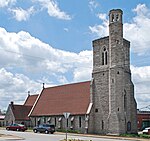Millie E. Hale Hospital

The Millie E. Hale Hospital was a hospital in Nashville, Tennessee that served African-American patients. It was the first hospital to serve black patients year-round. The hospital was opened by a husband and wife team, Dr. John Henry Hale and Millie E. Hale in July 1916. The couple first turned their home into a hospital that would grow to house 75 patients by 1923. In addition to the hospital, there was a community center and ladies' auxiliary that provided health services and also recreational and charity work to the black community. The hospital also provided parks for children who had no park to use in the Jim Crow era. In 1938, the hospital closed, but some social services continued afterwards.
Excerpt from the Wikipedia article Millie E. Hale Hospital (License: CC BY-SA 3.0, Authors, Images).Millie E. Hale Hospital
7th Avenue South, Nashville-Davidson
Geographical coordinates (GPS) Address Nearby Places Show on map
Geographical coordinates (GPS)
| Latitude | Longitude |
|---|---|
| N 36.153449 ° | E -86.777842 ° |
Address
7th Avenue South 550
37203 Nashville-Davidson
Tennessee, United States
Open on Google Maps






